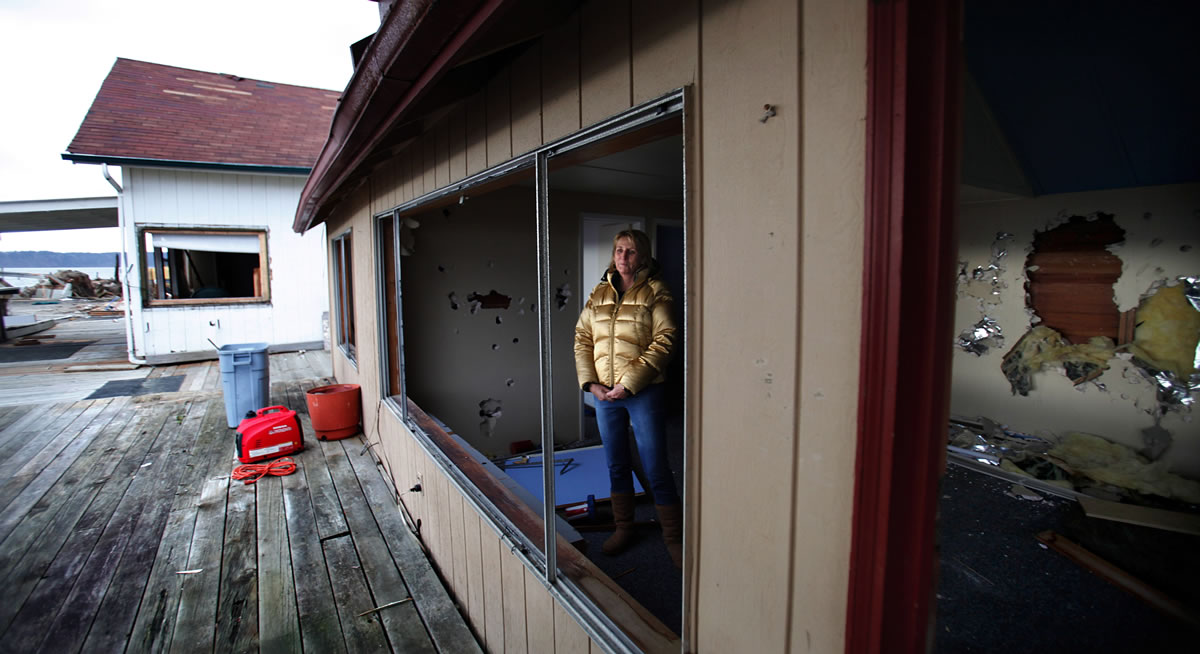TULALIP — For 50 years, Jaime Erickson’s family has been spending summers and weekends at their cabin on scenic Mission Beach.
Bruce Agnew’s family has had a cabin on the beach since 1925.
Mike Carey’s in-laws have had a place there for 90 years.
None of them owns the beachfront property on which their cabins sit, however. They’ve been leasing the land from the Tulalip Tribes, and the tribes want it back.
The 24 tenants had to be out by the end of December, and the cabins have to be gone by the end of March. The buildings — some basic, some funky, some quaint — are being taken apart and torn down, one by one.
“We’re all real sad. It’s a lot of memories,” said Erickson, 55, whose full-time home is in Everett.
The quarter-mile section of beach is southeast of Tulalip Bay, below 59th Street NW, also called Mission Beach Heights Road.
The cabins are built right on the beach, up against a steep slope. Most of the bank has been eroding for years, and landslides have been an issue, Tulalip spokeswoman Francesca Hillery said.
The tenants, most of them on long-term leases of up to 30 years, were given notice in 2005 that they had to be out by the end of 2012 — more than seven years ahead of time, Hillery said. They were sent reminder notices again in June, she said.
The leases stipulated that any structures on the property be removed at the renters’ expense when the lease expires, Hillery said. The leases also were intentionally timed to end simultaneously, she said.
The tribes haven’t yet decided what to do with the beach, but the most likely choice is to restore it to a natural state, Hillery said.
“The likelihood of doing anything other than restoring the beach doesn’t look good because of the instability of the slopes” and because of salmon recovery efforts, she said.
Hillery declined to comment on whether the public would have access to the beach if it is restored.
Erickson said the leases had been renewed so many times over the years that few thought they’d actually have to leave.
“Everyone’s in denial,” she said. “I never believed it.”
Residents said there is some anger about the situation, but at the same time, they understand the property isn’t theirs.
“A lease is a lease, unfortunately,” said Carey, who lives in Bellingham. “It is what it is.”
Only a few of the tenants lived at the beach full time, Erickson said. For most, the homes were part-time dwellings. Still, the families have spent so much time at their cabins over the years that leaving and tearing them down is difficult.
“The tribe has been working with us very closely, but the reality is my family has been there since 1925,” said Agnew, a former Snohomish County Council member. “Tribal members who are very family-oriented can certainly understand the tragedy in losing a place we’ve had since 1925 with irreplaceable family memories.”
The beach has a significant, colorful history.
The beach was named for a Catholic missionary church established nearby in the earliest years of the reservation, in 1858 by the Rev. E.C. Chirouse, according to Snohomish County historian David Dilgard.
In later years, the atmosphere at the beach was anything but pious.
Agnew, who grew up in Everett, said that early in the 20th century, his great-grandfather and others frequented fishing shacks on Mission Beach.
“The mining and fishing barons of Everett would go over and play cards and get away from their families,” he said. “They’d take tugboats out there and drink and gamble and carouse away from the watchful eye of their families on Rucker Hill.”
That tradition did not quite die out, according to Erickson.
The wooden decks on most of the homes ran together.
“It was just one big family. Everybody walked the deck and had cocktails with each other,” she said. “It was a fun, fun beach.”
The strip of sand boasts southwestern exposure with sweeping views of Whidbey Island, Hat Island, Possession Sound and Everett.
“The best time to be out there was with the storms and the connection with nature, the wild storms and tides,” said Agnew, who now lives on Mercer Island. “Where else do you find white sandy beach 45 minutes from downtown Seattle without railroad tracks in front and without a ferry to take? There’s no substitute for it.”
Some tenants are paying Carey, who has a construction business, to tear down their cabins with an excavator. He said most are paying him between $9,000 and $11,000.
Friends, relatives, acquaintances and charity groups have been salvaging fixtures and appliances, according to Erickson.
“It’s kind of a free-for-all. Everyone’s just coming out here and taking what they want,” she said.Some are having their places taken down piece by piece and hauled away by boat.
Agnew said it will be easier for tenants to accept their loss if the beach is restored to a natural condition.
Hillery said the tribes understand the families’ emotional connection to the beach. Tribal members also feel a connection, she said.
“It’s ancestral land,” she said. “It’s a very important cultural area to the tribe.”



